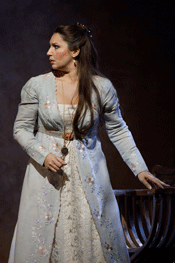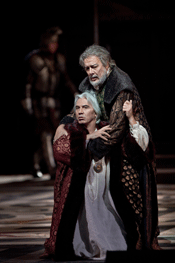01 Feb 2011
Simon Boccanegra, New York
A few years ago, a certain major newspaper boasted a music critic who could not bring himself either to take opera seriously or to deny himself the opportunity to review it.

A few years ago, a certain major newspaper boasted a music critic who could not bring himself either to take opera seriously or to deny himself the opportunity to review it.
The high jinks of opera were a thing he could never quite take seriously as music-making, perhaps because the melodramatic aspects of it, the colorful costumes and all that, offended him. He was also said to have a serious drinking problem, but let that pass. Simon Boccanegra, on its not infrequent Met revivals, came in for especial opprobrium: Drunk or sober, he could never make head or tail of the plot, and yet he would spend three or four paragraphs puzzling it through, mentioning the singers as an afterthought.
 Barbara Frittoli as Amelia
Barbara Frittoli as Amelia
There probably aren’t many people who go to Verdi operas for the sake
of the plot, and if there are, Simon Boccanegra, which has a great
deal of plot but doesn’t tie neatly together, is not the work to begin
with. Verdi was intrigued by its moments of charged drama but he didn’t
bother to fit the rest into a clear pattern. Those high points (Simon stumbling
on his lover’s body in the dark and, a moment later, being acclaimed as
Doge; Simon realizing that Amelia is his long-lost daughter; Simon quelling his
riotous subjects in the Council Chamber scene while Amelia trills gorgeously
over a ground bass of crowd noise; Simon dying of poison just as his daughter
and son-in-law return from the nuptial altar) should be sufficiently exciting
to quash your questions and carry you along. If they are not—if they are
not well sung and played, or if you insist on puzzling through untied ravels of
story—you are not going to have fun at Simon Boccanegra.
In recent years, Boccanegra has not always been cast to strength. There have certainly been worse Amelias than Barbara Frittoli, whose voice has the proper weight for a Verdi soprano, but her tone turns white and flat up top and she cannot sing softly up there (as every later Verdi heroine must be able to do). Too, she lacks that all-important trill. Ramón Vargas sings Gabriele Adorno with impressive urgency and well-judged voice placement, but the voice itself is no longer the lovely lyric tenor of ten years ago. Dmitri Hvorostovsky (in black wig for the prologue, his natural white locks for the remainder of the opera, set twenty-six years later) sings Simon the way he sings all Verdi: beautiful phrases with highly inappropriate gasping for breath in between them. This was not true when I first heard him sing this role, in Houston, a hall half the size of the Met, but it is always true when he sings Verdi at the Met. The house is too big for him or he just has not grasped how to produce Italian line here. But what other Verdi baritone does the Met have nowadays to take on the role?
Simon is a feast for low male voices. Ferruccio Furlanetto’s Fiesco had the same effect on the occasion that his King Philip had on the recent Don Carlo: Whenever he opened his mouth, the entire remainder of the cast seemed to sink into a provincial background, and we found ourselves in the presence of world-class singing. His acting, too, is full of dignity and pointed gesture, in the teeth of the absurdities required of Fiesco by director Giancarlo del Monaco. Fiesco is all about darkness and dignity, but del Monaco missed that memo and makes him a hysterical lout, raising his sword and roaring ineffectively around the stage at any opportunity. Furlanetto, purely by his low, velvet tones, reminded us that Fiesco is much more than that. Question to the Met: Why not give him Boris Godunov, a role that calls for just this sort of patriarchal authority? He sings the part to acclaim in out-of-the-way towns like Vienna and Venice.
 Dmitri Hvorostovsky in the title role and Ferruccio Furlanetto as Fiesco
Dmitri Hvorostovsky in the title role and Ferruccio Furlanetto as Fiesco
The Met has been shorthanded in the Verdi baritone field of late, but Nicola
Alaimo, who made his first Met appearances as the murderous Paolo in this run
of Boccanegra, is a most impressive addition to the field. His voice
is dark and sizable, and he has no trouble projecting Paolo’s cynicism,
his humor and, later, his vengeful rage. Pietro, his cohort, was sung
effectively by the ever-useful Richard Bernstein.
James Levine had conducted the season’s first performance of this opera last week, but by the next one, which I attended, he was evidently done in by the previous day’s thrilling account of Das Lied von der Erde with the Met Orchestra at Carnegie Hall, and he cancelled his second Boccanegra. Standing in was John Keenan, new to me and in perfect charge of the score: Each of Verdi’s sinister brass snarls came across vigorously (Verdi invented this effect for Boccanegra and maintained it for thirty years, through Otello). The flutes sounded lustrous as clarinets in the father-daughter music, and quarreled nobly with the strings in the daring disharmonies that underline civil dissent in Genoa. Keenan gave us all the power and excitement required for Verdi but he never once drowned out the singers.
Simon Boccanegra is set in fourteenth-century Genoa, indeed was composed in part as Verdi’s tribute to one of his favorite cities, but you’d never guess that from Giancarlo del Monaco’s colorful production—which jumps over centuries in order to add color to a backdrop here, a ceiling there, and even hops to Venice now and then for the sake of a prettier set design. Different stage directors have reworked it over the years, clumsily by and large. Peter McClintock, who was in charge this time, has rid us of several awkward touches, and has persuaded the chorus not to move as if they were a junior high school assembly when, in fact, they are rushing onto the stage in a fury in order to overthrow the government.
John Yohalem